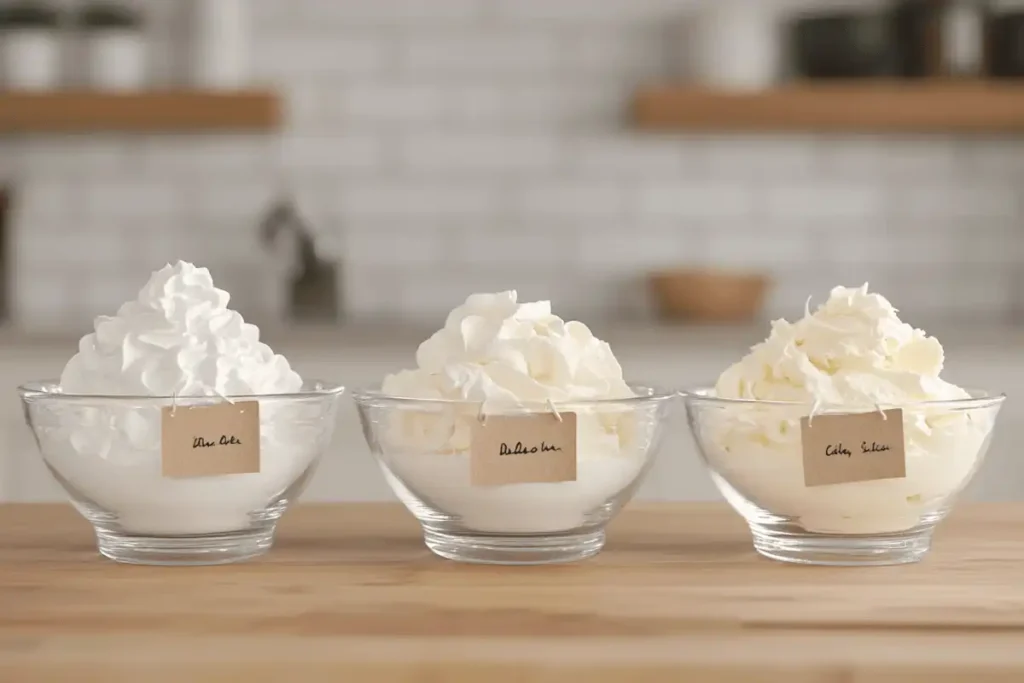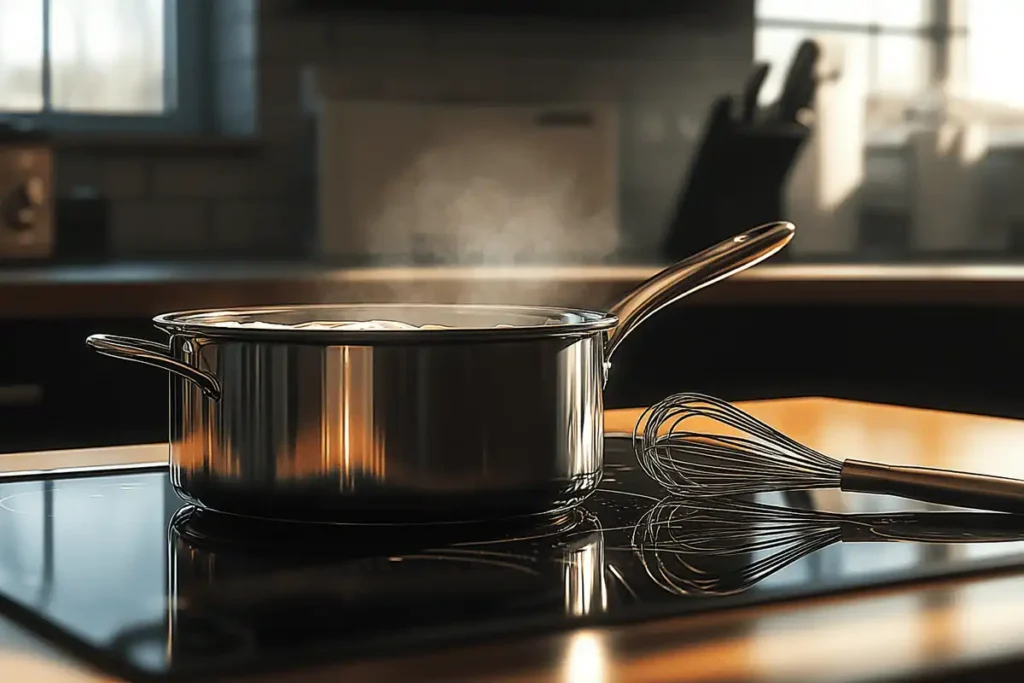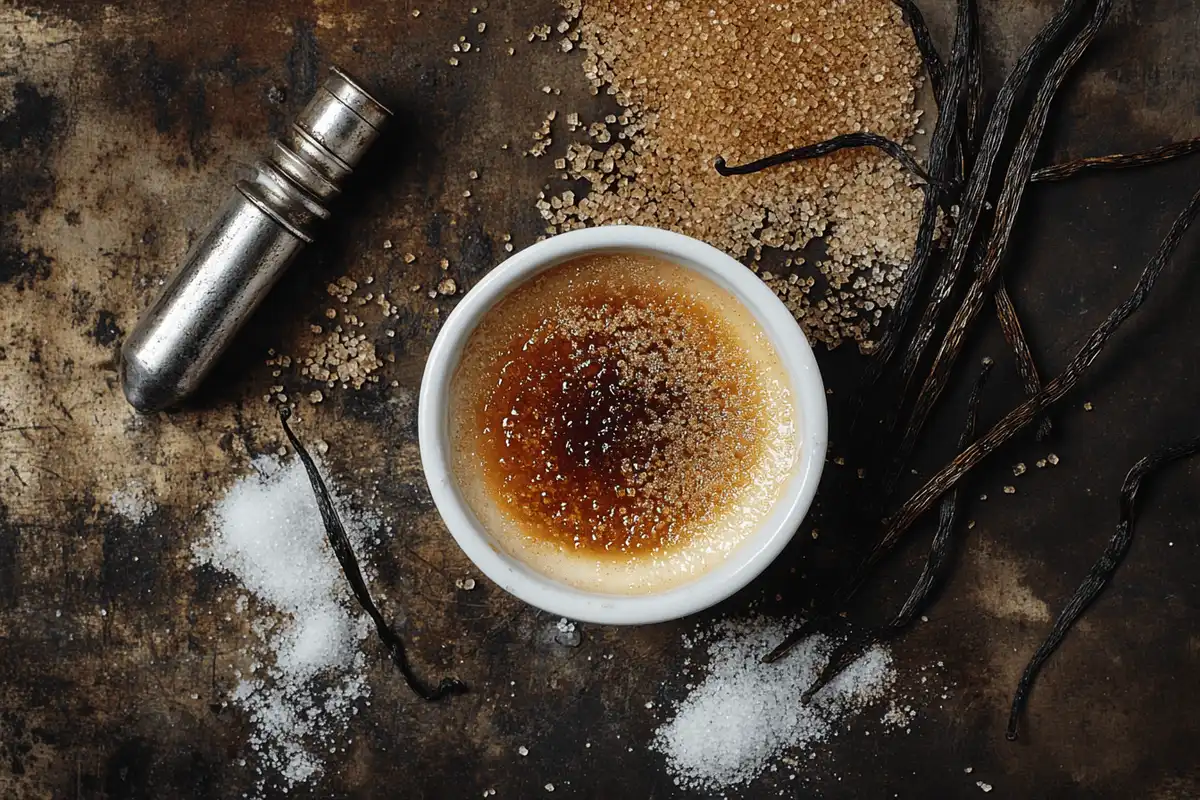Introduction
Crème brûlée is a timeless dessert that has captivated dessert lovers for generations. At its heart lies one essential ingredient: cream. But what type of cream is best for crème brûlée? Selecting the right cream can make or break the delicate texture and rich flavor of this classic treat. In this article, we’ll explore the role of cream in crème brûlée, discuss different types of cream, and offer practical tips to achieve custard perfection. Whether you’re a seasoned baker or a curious beginner, this guide has got you covered.
Understanding Crème Brûlée and Its Creamy Base
The Role of Cream in Crème Brûlée
The cream in crème brûlée isn’t just an ingredient—it’s the foundation of the dessert. It provides the custard’s silky texture and luxurious mouthfeel. When combined with eggs, sugar, and vanilla, cream transforms into a smooth base that’s both indulgent and satisfying. The high fat content in cream is what creates the rich consistency we all love, ensuring that each spoonful melts in your mouth.
But what exactly does cream do in this equation? It acts as a stabilizer, binding the egg yolks and sugar into a luscious custard. Additionally, cream plays a role in the baking process, allowing the custard to set evenly without becoming rubbery or overcooked.
Characteristics of an Ideal Cream for Crème Brûlée
Not all creams are created equal when it comes to making crème brûlée. The ideal cream has a milkfat content of 35% or higher, which ensures a thick and creamy consistency. Here are a few key characteristics of the perfect cream:
- High Fat Content: The richness of crème brûlée depends on fat. Heavy cream or double cream, with 35%-48% fat, is the gold standard.
- Lack of Stabilizers: Avoid creams with gelatin or other additives, as these can interfere with the texture of your custard.
- Freshness and Flavor: The fresher the cream, the better the flavor. Subtle differences in cream quality can have a noticeable impact on the final dessert.
When you understand the role and requirements of cream, you’re already halfway to mastering this iconic dessert. Up next, we’ll dive into the types of cream available and how they stack up for your perfect crème brûlée.
Types of Cream and Their Suitability for Crème Brûlée
Heavy Cream vs. Whipping Cream: What’s the Difference?
When deciding what type of cream is best for crème brûlée, heavy cream and whipping cream often top the list of contenders. At first glance, these two options may seem interchangeable, but their subtle differences can have a significant impact on your dessert.
- Heavy Cream: With a milkfat content of at least 36%, heavy cream creates a rich, smooth texture. Its higher fat content means it holds up well during baking, ensuring a custard that is both creamy and stable.
- Whipping Cream: Slightly lighter, with a milkfat content of 30%-35%, whipping cream can still work for crème brûlée but may produce a softer set. It’s best suited for recipes that call for slightly lighter textures.
For the ultimate indulgence, heavy cream is the preferred choice among chefs and home bakers alike.

The Role of Milkfat Content in Creating Texture
Milkfat is the secret ingredient that transforms simple cream into the velvety custard of crème brûlée. Higher fat content enhances the mouthfeel, providing a luscious creaminess that defines this classic dessert. A cream with at least 35% fat ensures that the custard will set properly while retaining its characteristic smoothness.
Lower-fat creams, while tempting for those watching calories, often lead to disappointing results. Custards made with such creams may turn out watery or fail to set altogether. Always check the label to ensure your cream has enough fat to work its magic.
International Cream Variations and Their Culinary Impacts
If you’re outside the U.S., the naming conventions for cream can be confusing. In Europe, “double cream” (48%+ fat) is a common choice, delivering an ultra-rich custard. Australians might opt for “pure cream” with no added stabilizers, while in some Asian countries, you may find creams labeled as “heavy” or “thickened,” often containing gelatins or thickeners that should be avoided.
Choosing the right cream is crucial for ensuring a smooth texture and even bake. For more on crème brûlée basics, check out this guide on achieving perfect caramelization.
Regional Recommendations for Cream Selection
Best Cream Options in the United States
In the U.S., heavy cream and heavy whipping cream are the go-to choices. These creams typically have a fat content of 36%-38%, ideal for creating the silky texture crème brûlée is known for. Avoid “light whipping cream,” as its lower fat content may lead to a runny custard.
For those seeking a premium touch, brands that emphasize organic or grass-fed options can elevate the flavor profile of your dessert.
European Cream Choices for Crème Brûlée
Europe boasts a variety of high-fat creams perfect for crème brûlée. In the U.K., “double cream” is a top-tier choice, thanks to its rich texture and fat content exceeding 48%. In France, “crème entière” or “crème double” offers similar results, delivering a decadent base for custard.
Italy and Germany also provide high-quality creams like “panna doppia” and “Konditorsahne,” making them excellent alternatives. European creams often have fewer additives, ensuring a purer taste and smoother texture.
Australian and Asian Cream Preferences
In Australia, “pure cream” is widely recommended for its lack of stabilizers and ideal fat content (35%-48%). This cream ensures a consistent bake without the risk of unwanted additives altering the flavor or texture.
In parts of Asia, “cooking cream” or “thickened cream” is common, but caution is needed. Always choose products without gelatin or stabilizers, as these can compromise the custard’s consistency.
Understanding regional cream options makes it easier to source the best ingredients, no matter where you are. You can explore more insights on cream-based recipes in this article about key differences between crème brûlée and custard.
How to Choose the Right Cream for Your Crème Brûlée Recipe

Reading Cream Labels for Ingredients and Fat Content
When selecting cream for crème brûlée, the label is your best friend. Look for creams with a fat content of at least 35%, as this ensures the rich and creamy texture the dessert requires. Terms like “heavy cream” or “double cream” often indicate suitable options. However, avoid products with added gelatin, stabilizers, or thickeners—they can alter the custard’s smooth consistency.
Be mindful of regional differences in labeling. For instance, in some countries, “thickened cream” may include additives that disrupt the delicate balance of the custard. Always check the ingredient list to ensure it’s just cream.
Evaluating Local Availability and Substitutions
Not all grocery stores carry the ideal cream, so flexibility is key. If heavy cream isn’t available, double cream (with a higher fat content) or a mix of heavy cream and whole milk can be used as a substitute. This mix replicates the fat content and flavor profile required for crème brûlée.
Non-dairy alternatives are becoming more popular, but they don’t offer the same results. If you’re experimenting with plant-based options, expect variations in texture and flavor.
For more tips on choosing the right cream for desserts, explore this helpful guide on crème brûlée essentials.
Tips for Achieving Perfect Consistency
Once you’ve chosen your cream, proper preparation is crucial. Scalding the cream—heating it until it’s just about to boil—enhances its flavor and ensures smooth mixing with the egg yolks. Avoid overheating, as it can scorch the cream or compromise its quality.
Consistency is also affected by baking technique. Use a water bath to create a gentle, even heat, preventing the custard from curdling. With the right cream and method, you’ll achieve a perfectly set custard every time.
Common Mistakes and Troubleshooting Tips
Issues with Low-Fat or Non-Dairy Creams
Using low-fat or non-dairy cream alternatives might seem appealing, but they can cause several issues. Low-fat creams lack the richness necessary for a classic custard, leading to a watery or runny texture. Non-dairy creams often contain stabilizers that can interfere with setting, making it challenging to achieve the silky smoothness crème brûlée is famous for.
If you must use an alternative, coconut cream is one of the better substitutes. Its high fat content makes it more compatible with the dessert, though it will impart a distinct flavor.
How Gelatin and Stabilizers Affect Texture
Stabilizers, like gelatin or carrageenan, can negatively impact the custard’s texture. These additives may create an artificial thickness or rubbery consistency. Always select a cream that is free from such ingredients for the best results.
If you accidentally use a cream with stabilizers, reduce the egg yolk quantity slightly to balance the custard mixture.
What to Do If Your Crème Brûlée Doesn’t Set Properly
If your crème brûlée doesn’t set, there are a few potential causes:
- Incorrect Cream: Using a cream with insufficient fat can prevent proper setting.
- Improper Baking: Ensure the custards are baked in a water bath at the right temperature.
- Over- or Under-Baking: The custard should jiggle slightly in the center when done. Overcooking can make it grainy, while undercooking leaves it unset.
For additional troubleshooting advice, check out this guide on crème brûlée preparation. Alternatively, visit the website for more dessert recipes and tips.
Frequently Asked Questions FAQs
Can I Use Non-Dairy Cream Alternatives?
Many wonder if non-dairy options can replace traditional cream in crème brûlée. While plant-based creams, such as almond or oat, might seem like a healthy swap, they often lack the high fat content needed to achieve the signature velvety texture. Coconut cream is a better choice due to its richness, but it will impart a distinct coconut flavor. If using non-dairy cream, experiment with small batches first to ensure the results meet your expectations.
Is Heavy Cream the Same as Double Cream?
No, heavy cream and double cream are not identical, though both work well for crème brûlée. Heavy cream typically contains 36%-38% milkfat, making it ideal for a creamy texture. Double cream, more common in the UK, boasts a higher fat content (48% or more), creating an even richer custard. If you’re unsure what type of cream is best for crème brûlée in your region, double cream can often be substituted for heavy cream with excellent results.
Can I Substitute Whipping Cream for Heavy Cream?
Whipping cream, which contains 30%-35% fat, is a suitable alternative for heavy cream, though the texture may be slightly lighter. For the creamiest custard, choose whipping cream with the highest available fat content. Lower-fat options may affect the custard’s ability to set properly.
What Happens If I Use Light Cream?
Light cream, with a fat content of 18%-30%, is not recommended for crème brûlée. Its low fat content can result in a watery custard that fails to set. If you’re in a pinch, consider blending light cream with whole milk or butter to boost the fat content.
Conclusion and Final Tips for Perfect Crème Brûlée
Choosing the right cream is the foundation of a successful crème brûlée. When selecting your ingredients, always opt for cream with a fat content of 35% or higher to achieve the luxurious texture that defines this classic dessert. What type of cream is best for crème brûlée depends on your region, but heavy cream, double cream, or pure cream are consistently excellent choices.
As you prepare your custard, remember to scald the cream for enhanced flavor and bake the custards in a water bath to ensure even cooking. Avoid stabilizers or additives in your cream, as these can interfere with the custard’s texture.
Finally, don’t be afraid to experiment within reason. Whether you’re trying a different cream blend or adding a unique twist to the recipe, practice makes perfect. For more insights and inspiration, check out the crème brûlée recipe and preparation tips available online.
With these tips in mind, you’re ready to create a dessert that’s sure to impress. Happy baking! Let me know if you’d like further assistance or additional resources.
Popular Variations and Flavor Enhancements for Crème Brûlée
Adding Flavored Cream for Unique Twists
If you’re wondering what type of cream is best for crème brûlée when experimenting with flavors, heavy or double cream remains the top choice. However, you can infuse these creams with flavors to elevate your dessert. Vanilla is the classic option, but don’t stop there—consider steeping the cream with lavender, cinnamon, or even coffee beans before mixing it into your custard. This infusion process enhances the depth of flavor without compromising the custard’s silky texture.
For a fruity twist, pair infused cream with a layer of berry compote at the bottom of each ramekin. The combination of tangy fruit and rich custard creates an unforgettable taste experience.
Pairing Crème Brûlée with Toppings and Add-Ons
While the caramelized sugar crust is the hallmark of crème brûlée, you can take your dessert to the next level by experimenting with toppings. Fresh fruits, edible flowers, or a drizzle of salted caramel can add layers of flavor and texture.
Another popular enhancement is using flavored sugars for the brûlée layer. For example, mixing brown sugar with a pinch of sea salt can provide a rich, toasty finish. These simple changes keep the dessert traditional yet exciting.
Storage and Reheating Tips for Crème Brûlée
How to Store Crème Brûlée Properly
After perfecting your crème brûlée, proper storage is key to maintaining its quality. Once the custards have cooled to room temperature, cover each ramekin with plastic wrap or foil to prevent a skin from forming on the surface. Store the desserts in the refrigerator for up to 3 days.
To preserve the crunch of the caramelized top, wait to torch the sugar until just before serving. This ensures the signature crack remains intact.
Reheating Crème Brûlée: Is It Possible?
While crème brûlée is best served fresh, reheating leftovers is possible if done carefully. Remove the custard from the fridge and allow it to come to room temperature for about 15 minutes. Avoid using a microwave, as uneven heating can ruin the texture. Instead, place the ramekins in a water bath and warm them in the oven at a low temperature (around 300°F or 150°C) for 5-10 minutes.
If the caramelized sugar layer has already been added, reheating may soften the crust. In this case, you can reapply a thin layer of sugar and re-torch it to restore the desired crunch.
By following these tips, you’ll ensure your crème brûlée remains as delightful as the day it was made.

